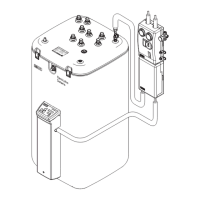5 x Operation
29
FA ROTEX Solaris RPS3 P2 - 06/2012
The pumps are switch off when:
– The temperature difference falls below the value set at parameter "Delta T off" (e.g. return temperature = 45 °C and
"Delta T off" = 2 K; Solaris feed temperature <47 °C).
– If the maximum storage tank temperature set in parameter "T
S
max" is reached (T
S
indicator flashes). In this case the
pumps can only be started again if the storage tank temperature has fallen by more than 2 K.
– If the maximum solar panel temperature set in parameter "T
k
zul" is reached (T
k
indicator flashes). In this case the pumps
can only be started again if the solar panel temperature has fallen by more than 2 K.
5.2.2 Switch-on lock-out function
The switch-on lock-out function prevents:
– reactivation if the solar system has been automatically shutdown because the set maximum storage tank temperature
"T
S
max" has been reached.
– pump operation if the solar panel temperature exceeds the value set by the heating expert with the parameter "T
K
zul".
Under sustained solar radiation temperatures over 100 °C may occur at the solar panels after switching off the pumps. If the
storage tank temperature falls below the release temperature ("T
S
max" – 2 K) in this situation (e.g. by removal of hot water),
the pumps are switched on again when the cut-in switch protection temperature at the solar panels set with parameter "T
K
zul"
falls by 2 K. The T
K
indicator flashes.
The lock-out time "Time SP" function allows the pumps to be released again in a shutdown condition caused by the feed sensor
(FlowSensor) only after expiry of the lock-out time set in the Solaris R3P control system (0 – 600 s).
Therefore:
– cycling of the system can be minimised.
– the solar panels can reach a higher temperature.
– the feed temperature during filling the system does not fall below the cut-out condition and the system regulates itself faster.
If a FlowSensor is not installed or is faulty, the P1 tank circulation pump runs constantly at the set output level
(without speed control). The pumps are regulated exclusively by the temperature difference between the solar
panel and Solaris return flow temperature.
ţT
OFF
Switch-on temperature difference
ţT
ON
Switch-on temperature difference
P
S1
Tank circulation pump
P
S2
Solar panel circulation pump
tTime
T
K
Collector temperature
T
R
Return flow temperature
T
V
Flow temperature
Zeit
PsA
Tank circulation pump cut-out delay
Zeit
PsE
Tank circulation pump cut-in delay
Zeit
UB
Reverse condition delay time
1 Tank circulation pump cut-in delay:
For maximum use of the heat the solar panel circuit is started before
circulating the storage tank circuit. The preheated plate heat
exchanger can heat immediately with the time-offset start of the tank
circulation pump.
2 Tank circulation pump cut-out delay:
To prevent temperatures >100 °C in the plate heat exchanger after
the solar panel circulation pump switches off, for the Time
PsA
set in
the parameters.
Fig. 5-2 Start sequence for storage tank and solar panel circulation pump

